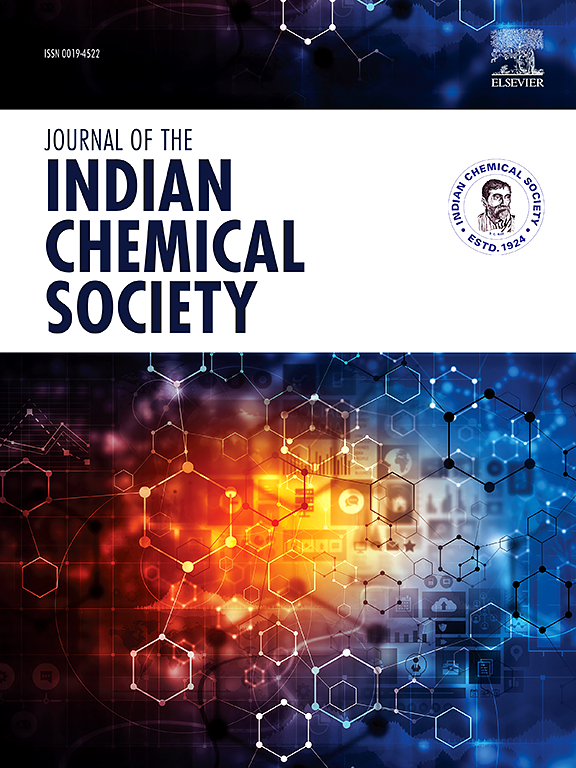Conformational diversity in biogenic terpenoid linalool: Liquid phase FTIR spectroscopic and quantum chemical studies
IF 3.2
4区 化学
Q2 CHEMISTRY, MULTIDISCIPLINARY
引用次数: 0
Abstract
The conformational diversity of linalool, a biogenic terpenoid, has been investigated in detail through IR spectroscopy and quantum chemical calculations. Theoretical conformational analysis reveals that energetic stability is guided primarily by the orientation of the tertiary hydroxyl group, the only polar entity, about the extended hydrophobic part of the molecule. The most stable conformers are those in which this group is intramolecularly hydrogen bonded to the π-bond in the δ-position. Natural Bond Orbital analysis demonstrates that the remote hyperconjugative interaction between the filled π-bonding orbital and the vacant anti-bonding σ∗ orbital on the O–H bond is responsible for the intramolecular interaction. The presence of a bond critical point along the O–H … π bond path, as obtained from electron density topology studies using Atoms-in-Molecules analysis confirms the interaction. A full vibrational analysis of the global minimum conformer has been reported. Thermal solvation in CCl4 solution reveals the co-existence of this conformer with those of higher energy, as obtained from a detailed comparison of the experimental spectrum with theoretically predicted conformationally averaged spectrum. The self-dimers of linalool have also been investigated both experimentally and theoretically. It is evidenced that in solution, the π-hydrogen bond in one or both of the dimer constituents opens up, as it enters into an intermolecular O–H⋯O hydrogen bonded interaction. Also, in the heterodimeric complexes of linalool with proton accepting solvents tetrahydrofuran and deuterated dimethyl sulfoxide, respectively, the open non-π-hydrogen bonded form is energetically much more preferred than the closed π-hydrogen bonded form. Such conformational switching of linalool in its dimeric forms as compared to its monomeric form is attributed to the decrease in the classical energetic barrier of conversion from the closed to the open forms as a result of specific intermolecular association.

生物源萜类芳樟醇的构象多样性:液相FTIR光谱和量子化学研究
通过红外光谱和量子化学计算,详细研究了芳樟醇的构象多样性。理论构象分析表明,能量稳定性主要由叔羟基(唯一的极性实体)在分子扩展的疏水部分的取向所引导。最稳定的构象是分子内氢键在δ位置与π键成键的构象。自然键轨道分析表明,分子内相互作用是由O-H键上填充的π键轨道和空的反键σ *轨道之间的远超共轭相互作用引起的。在O-H - π键路径上存在一个键临界点,这是通过使用原子-分子分析的电子密度拓扑研究得到的,证实了相互作用。对全局最小共形体进行了完整的振动分析。在CCl4溶液中的热溶剂化表明该构象与高能量构象共存,这是通过对实验谱与理论预测的构象平均谱的详细比较得到的。对芳樟醇的自二聚体也进行了实验和理论研究。研究证明,在溶液中,二聚体中一个或两个组分的π-氢键打开,因为它进入分子间O -h⋯O氢键相互作用。此外,在芳醛与质子接受溶剂四氢呋喃和氘化二甲亚砜的异二聚体配合物中,开放的非π-氢键形式在能量上远优于封闭的π-氢键形式。与单体形式相比,二聚体形式的芳樟醇的这种构象转换归因于由于特定的分子间结合,从封闭形式转化为开放形式的经典能量屏障减少。
本文章由计算机程序翻译,如有差异,请以英文原文为准。
求助全文
约1分钟内获得全文
求助全文
来源期刊
CiteScore
3.50
自引率
7.70%
发文量
492
审稿时长
3-8 weeks
期刊介绍:
The Journal of the Indian Chemical Society publishes original, fundamental, theorical, experimental research work of highest quality in all areas of chemistry, biochemistry, medicinal chemistry, electrochemistry, agrochemistry, chemical engineering and technology, food chemistry, environmental chemistry, etc.

 求助内容:
求助内容: 应助结果提醒方式:
应助结果提醒方式:


